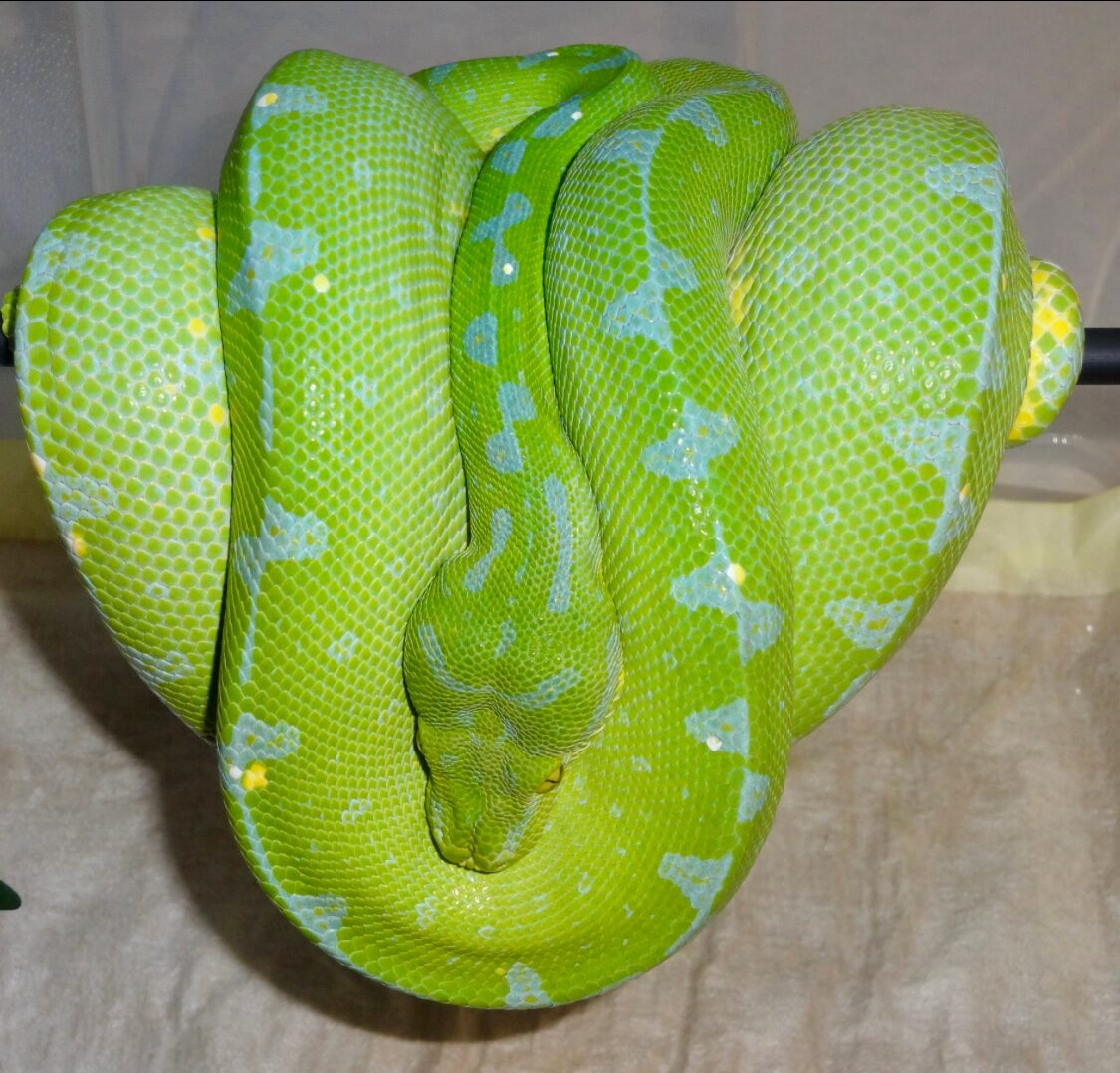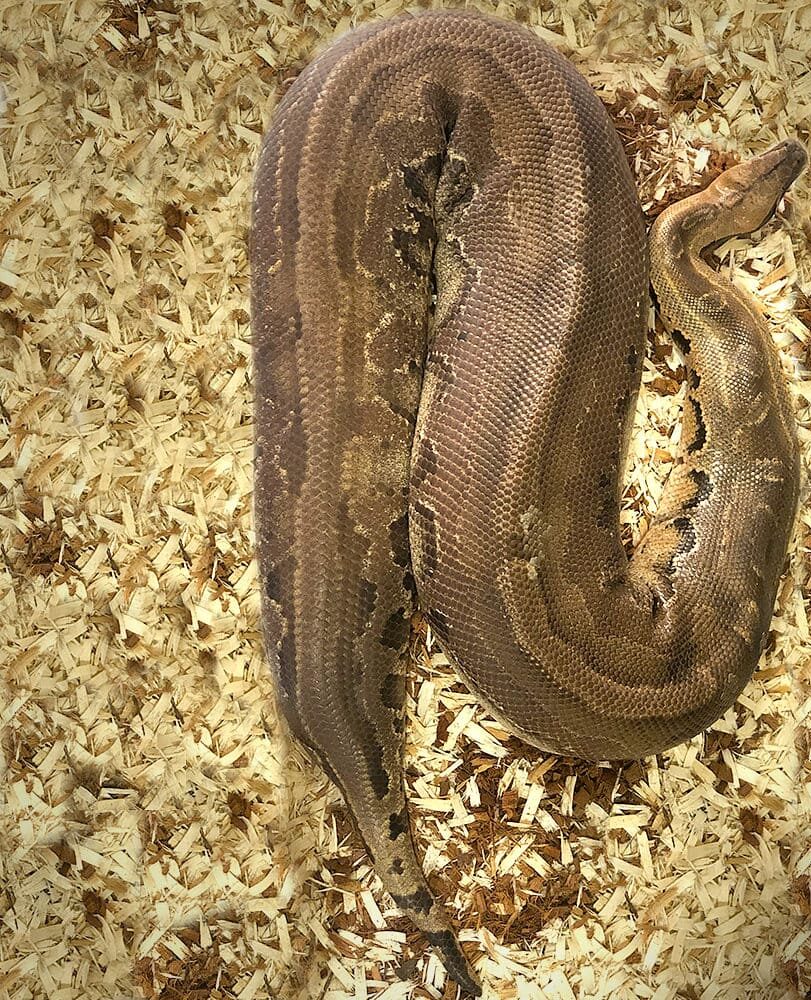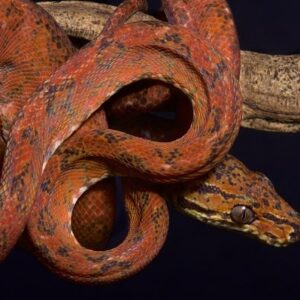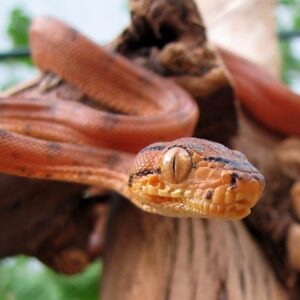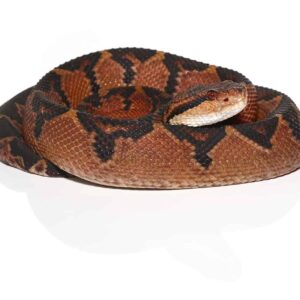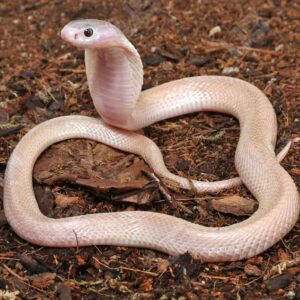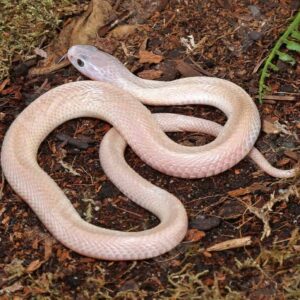Adult Blood Python For Sale
$999.99
WE HAVE ADULT BLOOD PYTHON FOR SALE. HERE ARE SOME HIGHLIGHTS:
- Python brongersmai
- Captive Bred
- Females and Males
- Approximately 6 Feet In Length
- Adults Will Average Around 4 – 6 Feet In Length
- Feeding On Live Or Frozen Thawed Large Rats
FUN FACTS!
- This Species Can Be Feisty But With Regular Handling Tames Down Well
- Originating From The Island Of Borneo And Sumatra In Indonesia
- Blood Pythons Are Terrestrial Snakes Living Their Lives On The Forest Floor Blending In With The Leaf Litter And Attacking Prey By Surprise
- With Proper Care And Setup These Snakes Can Live Up To 20 – 25 Years In Captivity
Description
The blood python, scientifically known as Python brongersmai, is a captivating species that has piqued the interest of herpetologists and exotic pet enthusiasts alike. These non-venomous reptiles are recognized for their robust and muscular build, with adults typically reaching lengths of 4 to 6 feet. One of the most striking features of blood pythons is their vivid coloration, which can range from deep reds and oranges to rich browns and yellows. This vibrant hue is the origin of their common name, as it resembles the color of blood.
Blood pythons are indigenous to the swamps, marshes, and tropical rainforests of Southeast Asia, particularly in regions like Thailand, Malaysia, and Sumatra. These environments provide the humidity and shelter necessary for their survival. In the wild, blood pythons are ground-dwellers, often found hiding under leaf litter or in burrows. Their natural habitat is characterized by dense vegetation and a moist climate, which supports a diverse ecosystem of prey such as rodents and birds.
Historically, blood pythons have been a subject of fascination due to their unique appearance and behavior. They were first scientifically described in the early 19th century, and since then, they have been studied extensively to understand their ecological role and adaptive strategies. In recent decades, blood pythons have gained popularity in the exotic pet trade. Their striking appearance and relatively manageable size make them appealing to reptile enthusiasts. However, prospective owners should be aware that blood pythons require specific care and conditions to thrive in captivity, including appropriate humidity levels and a diet that mimics their natural prey.
Overall, blood pythons are a remarkable species with a rich history and distinct characteristics. Whether observed in their natural habitat or as part of the exotic pet trade, these pythons continue to captivate and intrigue those who encounter them.
Physical Characteristics
Blood pythons (Python brongersmai) are renowned for their distinctive and robust physical attributes, which set them apart from other python species. One of the most notable features of blood pythons is their heavy-bodied structure. These snakes possess a stout, muscular build, making them appear more substantial in girth compared to other pythons. This characteristic not only contributes to their powerful presence but also aids in their predatory efficiency.
The coloration and patterning of blood pythons are equally remarkable. They typically exhibit a striking combination of deep reds, browns, and black hues, which can vary significantly among individuals. These colors often form intricate patterns and blotches across their scales, providing excellent camouflage in their natural habitats. The vivid red coloration, in particular, is a signature trait that has earned them the name “blood python.”
In terms of size, blood pythons are relatively moderate compared to some of their larger python relatives. On average, they measure between 4 to 6 feet in length, with some individuals occasionally reaching up to 8 feet. Despite their shorter length, their substantial girth gives them a formidable appearance. Adult blood pythons typically weigh between 10 to 15 pounds, although larger specimens can exceed this range.
Sexual dimorphism is present in blood pythons, with females generally being larger and heavier than males. This size difference is most noticeable in mature individuals, where females can significantly outweigh their male counterparts. The larger size of female blood pythons is an adaptation that supports reproductive success, allowing them to produce and carry more eggs.
These unique physical characteristics collectively distinguish blood pythons from other python species. Their robust build, vibrant coloration, and moderate size make them a fascinating subject of study and a popular choice among reptile enthusiasts. The sexual dimorphism observed in this species further adds to their intriguing biological profile, providing insights into their reproductive strategies and ecological adaptations.
Behavior and Temperament
Blood pythons, native to the tropical regions of Southeast Asia, are known for their unique behavior and temperament. Traditionally, they have garnered a reputation for being somewhat defensive, especially when compared to other python species. This defensive nature is often attributed to their natural habitat, where they must be vigilant against predators. However, with consistent and proper handling, blood pythons can acclimate to captivity and exhibit a more docile demeanor. It is crucial to understand that their initial defensiveness is a survival instinct rather than an inherent aggressive trait.
In terms of feeding habits, blood pythons are primarily ambush predators. They rely on their cryptic coloration to blend into their environment, waiting patiently for prey to come within striking distance. In captivity, they typically feed on appropriately sized rodents. It is important to maintain a regular feeding schedule to ensure their health and well-being. Overfeeding should be avoided, as blood pythons are prone to obesity.
Blood pythons are generally more sedentary compared to other snakes. They have low activity levels and prefer to remain in a secure hiding spot, especially during daylight hours. This behavior is consistent in both wild and captive environments, underscoring the importance of providing adequate hiding places within their enclosure. In the wild, blood pythons are often found in burrows or under dense foliage, emerging primarily at night when they are more active.
Interaction with their environment is another fascinating aspect of blood python behavior. In captivity, enrichment items such as logs, hides, and substrate variation can stimulate their natural behaviors. While blood pythons are not known for climbing, providing a varied and engaging habitat can contribute to their overall well-being. Understanding their behavior in both wild and captive settings can help keepers provide the best care, ensuring these captivating reptiles thrive.
Diet and Feeding
Blood pythons, native to Southeast Asia, have evolved to thrive on a diet primarily composed of small mammals and birds. In the wild, their diet includes various species of rodents, such as rats and mice, as well as avian prey. This carnivorous diet is vital for sustaining their energy levels, growth, and overall health.
When it comes to blood pythons in captivity, replicating their natural diet is essential for their well-being. Juvenile blood pythons typically require more frequent feedings compared to adults due to their rapid growth rates. It is recommended to feed juveniles every five to seven days, offering appropriately sized prey items such as fuzzies or hoppers. These smaller prey items ensure that the young snakes receive adequate nutrition without causing digestive stress.
As blood pythons transition to the sub-adult stage, their feeding frequency can be adjusted to once every seven to ten days. Sub-adults can handle larger prey, such as adult mice or weanling rats, which provide the necessary nutrients to support their continued growth and development. Monitoring the snake’s body condition and adjusting the prey size accordingly can help maintain optimal health.
Adult blood pythons, which have slower metabolisms, should be fed less frequently. A feeding interval of every 10 to 14 days is generally sufficient, with prey items like adult rats being appropriate. It’s crucial to avoid overfeeding, as obesity can lead to various health issues in these snakes. Regularly assessing the snake’s body condition and adjusting the feeding schedule as needed can prevent overfeeding.
Proper hydration is another critical aspect of maintaining a healthy diet for captive blood pythons. Providing a clean and accessible water source at all times is essential. Additionally, ensuring that the enclosure has adequate humidity levels can aid in hydration and overall health. By mimicking the natural diet and habitat conditions, keepers can ensure their blood pythons thrive in captivity.
Habitat and Enclosure Requirements
Creating an ideal enclosure for blood pythons in captivity is crucial for their health and well-being. Proper habitat management ensures that these fascinating reptiles thrive under human care. The enclosure size is an essential starting point. For an adult blood python, a minimum enclosure size of 4 feet in length, 2 feet in width, and 1.5 feet in height is recommended. This space allows for adequate movement and enrichment activities.
Temperature and humidity are critical factors in maintaining a suitable environment. Blood pythons originate from regions with high humidity and warm temperatures. Therefore, it’s vital to mimic these conditions in captivity. Provide a temperature gradient within the enclosure, with a basking spot maintained at around 88-92°F and a cooler area between 78-82°F. Humidity levels should be kept between 50-70%, which can be achieved by regular misting and the use of a hygrometer to monitor levels.
Choosing the right substrate is also important for the enclosure. Substrates such as cypress mulch, coconut husk, or aspen shavings are popular choices due to their ability to retain moisture, thus helping to maintain humidity levels. Avoid using substrates like sand or gravel, as they can cause impaction if ingested. Regular substrate cleaning is crucial to prevent bacterial growth and maintain a hygienic environment.
Blood pythons are naturally secretive and require hiding spots to feel secure. Providing multiple hide boxes throughout the enclosure helps reduce stress. These hides can be commercially bought or handmade using materials like plastic containers or cork bark. Additionally, while blood pythons are not avid climbers, offering some climbing opportunities with sturdy branches or logs can enhance their environment and encourage natural behaviors.
Maintaining a clean and stress-free environment is paramount. Regularly clean the enclosure and remove any waste. Ensure that fresh water is always available and that the enclosure is free from sharp objects that could injure the snake. By adhering to these guidelines, you can create a habitat that supports the health and longevity of your blood python, fostering a rewarding experience for both the keeper and the snake.
Health and Common Issues
Blood pythons, like any other reptile, are susceptible to various health issues that can affect their well-being if not properly addressed. Among the most common ailments are respiratory infections, mites, and scale rot. Recognizing the early signs of these illnesses is crucial for timely intervention and effective treatment.
Respiratory infections in blood pythons often manifest through symptoms such as wheezing, nasal discharge, and open-mouth breathing. These infections can be caused by inadequate humidity levels, poor ventilation, or exposure to pathogens. To prevent respiratory issues, it is essential to maintain optimal humidity levels and ensure that the enclosure is well-ventilated.
Mites are another common problem, presenting as small, dark specks moving on the python’s skin. Infestations can lead to irritation, stress, and secondary infections. Regularly inspecting your blood python and its enclosure for signs of mites and practicing good hygiene can help prevent infestations. If mites are detected, commercially available reptile-safe mite treatments should be used.
Scale rot is a bacterial infection that affects the scales and skin of blood pythons, often caused by prolonged exposure to damp, unsanitary conditions. Symptoms include discolored, blistered, or necrotic scales. Preventive care involves maintaining a clean and dry enclosure, promptly addressing any spills, and ensuring proper substrate use.
Regular health check-ups with a reptile veterinarian are invaluable for early detection and management of potential health issues. It is also advisable to quarantine new arrivals for a minimum of 30 days before introducing them to existing collections, thereby reducing the risk of disease transmission.
Preventive care practices are paramount in maintaining the health of blood pythons. This includes maintaining proper hygiene, monitoring environmental conditions, and seeking professional veterinary advice when needed. By adhering to these practices, owners can ensure that their blood pythons remain healthy and thrive in captivity.
Breeding Blood Pythons
Breeding blood pythons requires thorough preparation and an understanding of their unique reproductive behaviors. The process begins with the careful selection of breeding pairs. Both male and female blood pythons should be in optimal health, with the female typically weighing at least 2.7 kilograms to ensure she can safely carry and lay eggs. It’s essential to quarantine new breeding stock for several months to prevent the introduction of diseases.
Temperature cycling plays a crucial role in stimulating breeding. This involves gradually reducing the temperature in the enclosure over a period of weeks to simulate the winter season, followed by a gradual increase to mimic spring. During this period, daytime temperatures may drop to around 26°C (79°F), with nighttime temperatures falling to 21°C (70°F). After several weeks, temperatures should be gradually raised back to the normal range of 29-31°C (84-88°F).
Humidity control is equally important. Maintaining a relative humidity of around 60-70% can help create an environment conducive to breeding. Mating typically occurs shortly after the temperature begins to rise. Observing mating behavior such as courting, where the male wraps around the female and aligns his body to hers, is a positive sign that breeding is taking place.
Once mating has successfully occurred, the female blood python will undergo a pre-lay shed approximately two weeks later, followed by the laying of eggs. Incubation of the eggs requires a stable temperature of around 31°C (88°F) and a humidity level of 90-100%. Eggs generally hatch after about 60 days of incubation.
Hatchlings require special care to ensure their survival and growth. They should be kept in smaller enclosures with controlled temperature and humidity, and offered appropriately sized prey items. Breeders may encounter challenges such as non-feeding hatchlings or health issues, which require prompt attention and care.
Overall, breeding blood pythons demands a commitment to detailed care and environmental management. Success in this endeavor not only contributes to the conservation of these fascinating reptiles but also provides a rewarding experience for dedicated breeders.
Conservation and Ethical Considerations
The conservation status of blood pythons (Python brongersmai) in the wild is a topic of increasing concern among herpetologists and conservationists. These fascinating reptiles are native to Southeast Asia, particularly in regions such as Sumatra, Peninsular Malaysia, and parts of Thailand. Due to habitat destruction, primarily from agricultural expansion and deforestation, their natural habitats are shrinking. This environmental pressure has significant implications for their populations.
In addition to habitat loss, the pet trade has notably impacted blood python populations. While blood pythons are popular among reptile enthusiasts due to their striking appearance and relatively manageable size, the demand for these snakes has led to over-collection in the wild. This practice not only reduces wild populations but also disrupts local ecosystems where these pythons play a crucial role as both predator and prey.
Responsible ownership is paramount for those considering keeping blood pythons as pets. Prospective owners should ensure they acquire their pythons from reputable breeders who prioritize the health and genetic diversity of their animals. Ethical breeding practices are essential to prevent inbreeding and genetic anomalies, which can lead to health issues in captive populations. Furthermore, owners should be educated about the specific needs of blood pythons, including their habitat requirements, dietary needs, and health care, to provide a high standard of welfare.
Supporting conservation efforts is also crucial. This can be achieved through donations to organizations dedicated to preserving natural habitats and wildlife, participating in awareness campaigns, and advocating for sustainable practices that minimize environmental impact. By making informed choices and supporting ethical practices, enthusiasts can contribute positively to the conservation of blood pythons and their natural environments.
Ultimately, the survival of blood pythons in the wild hinges on our collective actions. By fostering responsible ownership, supporting ethical breeding, and contributing to conservation efforts, we can help ensure that these remarkable reptiles continue to thrive both in captivity and in their natural habitats.



